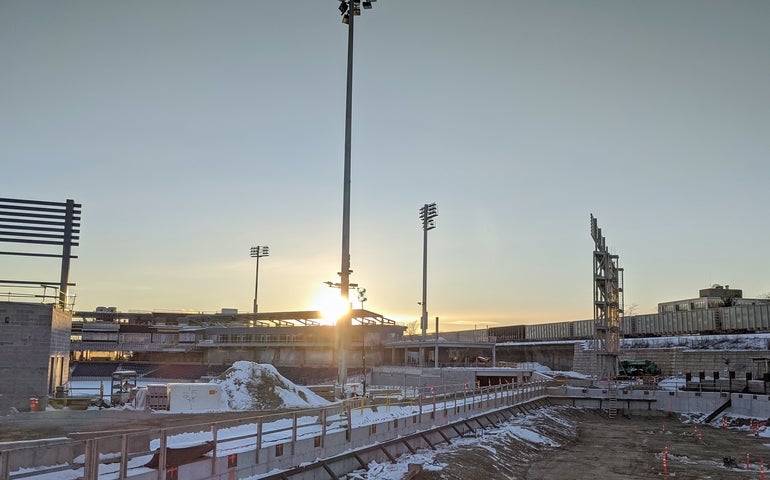Before announcing their plan in August 2018 to bring the Pawtucket Red Sox minor league baseball team to Worcester, city and team leaders already decided exactly where and when the team would move.
A stadium would be built mostly on a hillside parking lot, and where five commercial buildings once stood in the Canal District. The team would start play in its new home in April 2021, since its stadium lease in Pawtucket ended in 2020.
Those decisions – where and when – would send both the city and the now renamed Worcester Red Sox down a fast-moving, complicated path, pushing costs up from the initial $100.8 million estimate to the newly updated $159.5 million today. The site proved far more challenging than even expected, the design plans remained unfinalized until well after construction began, and the ambitious 31-month planning and construction timeline left little wiggle room for changes without significant costs, City Manager Edward Augustus wrote to the City Council in a Jan. 8 memo.
“After the design development process was completed in the fall of 2019, it was clear that the project team underestimated the costs associated with this unique site,” Augustus wrote.
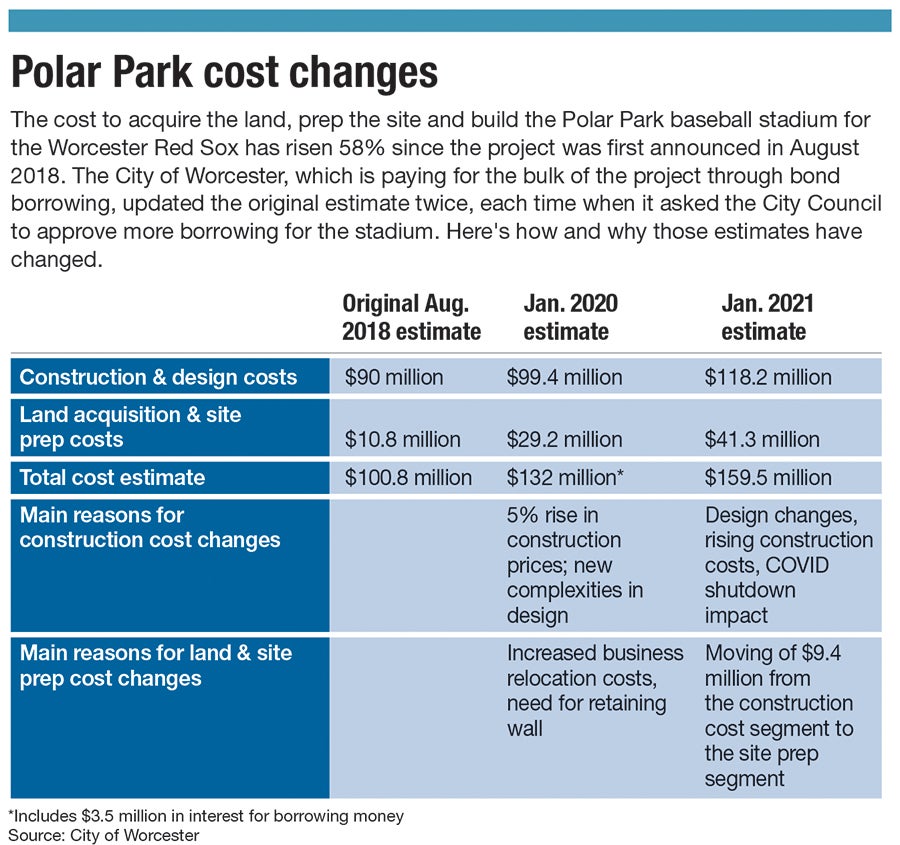
The construction of the Polar Park baseball stadium appears likely to be completed by the original April deadline. When the team actually begins play in Worcester will be decided by negotiations between Major League Baseball and the MLB Players Association over the impact of the coronavirus pandemic; and when fans can begin attending games at Polar Park will depend on the Massachusetts regulations on outdoor gatherings, which are currently capped at 25 people.
Although the pandemic caused a seven-week shutdown during prime construction season in late spring, Augustus said the direct impact from COVID on the stadium cost was $1.62 million, or about 1% of the total project cost. The city received a $1.5-million reimbursement from the federal CARES Act for this expense. Augustus wrote the pandemic did add indirect and hard-to-measure costs to the project, such as impact on supply chains for materials like lumber, steel and glass.
Rough initial estimates
The first cost estimate for the project was untenable, Augustus wrote.
Before the project was publicly announced, based on the type of stadium the team wanted to build compared to similar stadiums, the cost was estimated to be $73 million, although this was adjusted to $86 million-$90 million in the original August 2018 proposal because the anticipated challenges of the planned site’s topography, as the stadium had to be built into a hill with a slope of roughly 18 feet from north to south.
“Getting out of the ground is always hardest,” said Robert Brehm, a construction engineering professor at Drexel University in Philadelphia, who reviewed Augustus’ memo regarding the Polar Park overruns for WBJ.
“That site isn’t ideal for a ballpark,” Brehm said.
[Read detailed site contamination and remediation reports here and here]
Augustus said topographic and soil issues on the ballpark footprint itself, along with buying and knocking down commercial buildings standing in the way, were underestimated. In one instance, the city had to pay $6 million to relocate a data center from one of the buildings.
At the time these underestimates were realized, construction was already a few months underway. That meant while construction was ongoing, planners were making what Augustus described as significant design changes to fit within the project’s budget.
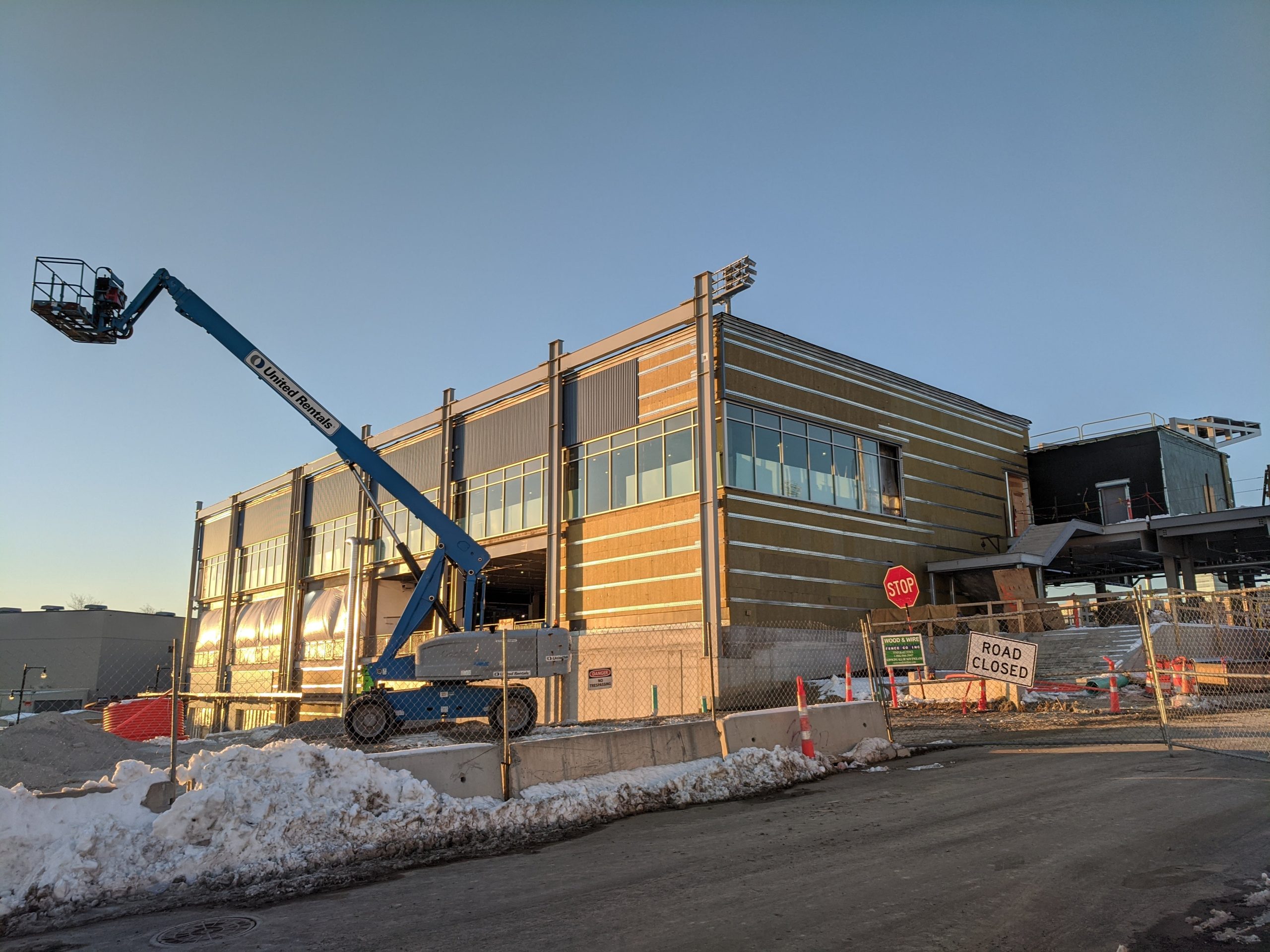
Because planning documents were rushed, some were incomplete according to state construction document guidelines, pushing up costs yet further, Augustus said. A delayed design also pushed back the process for obtaining construction materials.
Later into the process, high costs forced engineers to redesign the project once construction was underway.
“The further on into the project you go, the more expensive changes become. Because you’re invariably doing things that cost more money now,” Brehm, the Drexel professor, said.
Wish-list design
The WooSox initial design plan for Polar Park was more of a wish list that had to be pared down, said Peter Dunn, the city’s chief development officer, in an interview with WBJ.
The early-stage cost estimate from the city was based on the information available to city and team officials at the time, Dunn said. In one example, soil tests for environmental remediation typically need to be done over longer periods of time than the city and team had.
“That’s just the nature of construction in some cases,” Dunn said.
[Read past WBJ coverage of Polar Park]
Philip Barlow, a construction management professor at California Polytechnic State University who reviewed the Polar Park project for WBJ, said basing costs off of similar construction in other locations is a precarious way of doing initial estimates and leads to overruns.
“That is a very risky, and very rudimentary and a very, quick broad-brush way of creating initial estimates,” Barlow said.
Even factoring in aspects out of the control of project leaders like the coronavirus pandemic, having the costs rise $58.7 million is not typical of projects, even one of this scale, he said.
“Those cost overruns are inexcusable,” Barlow said.

The WooSox goal is to create a world-class stadium equal to the best facilities in minor league baseball. In the team’s finalized 35-year lease agreement with the city, the deal calls for Polar Park’s quality to be on par with minor league stadiums in El Paso, Texas; Charlotte, N.C.; and Columbus, Ohio, whose construction costs range from $59 million to $84 million in 2021 dollars.
“We are confident the experienced team of architects, engineers and construction professionals will complete this with a quality craftsmanship and attention to design that will make Worcester proud,” said Janet Marie Smith, the renowned stadium architect who designed Camden Yards in Baltimore and advised the Polar Park team on the project.
The 31-month timeline for project completion was a challenge, similar to all projects of this scale, Smith said.
“We admire the city’s leadership, particularly with the challenges of this global pandemic, and are excited about our 35 years ahead together,” she said.
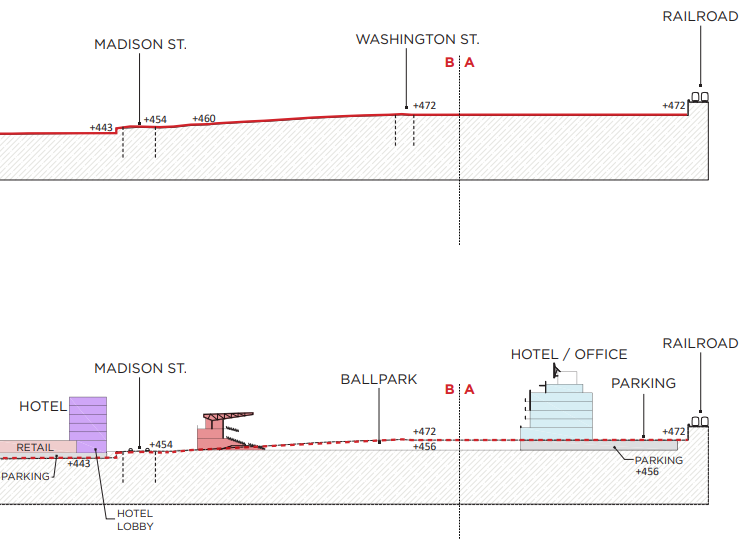
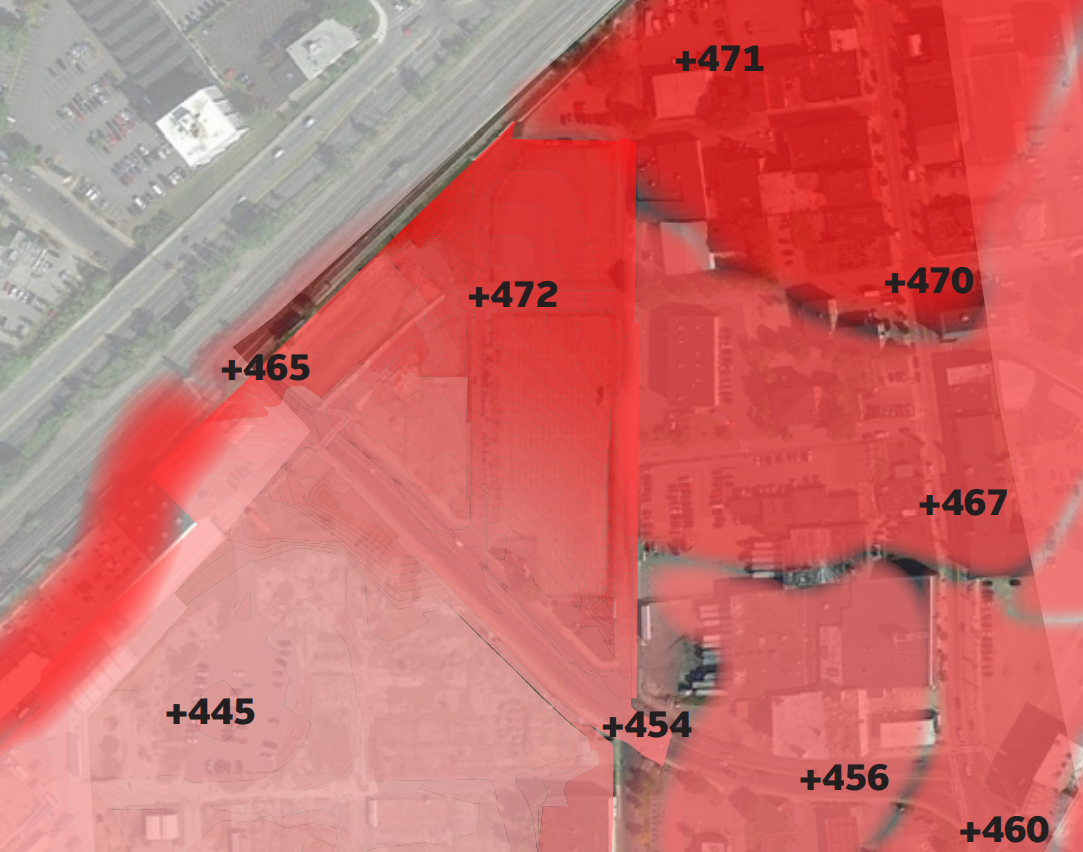
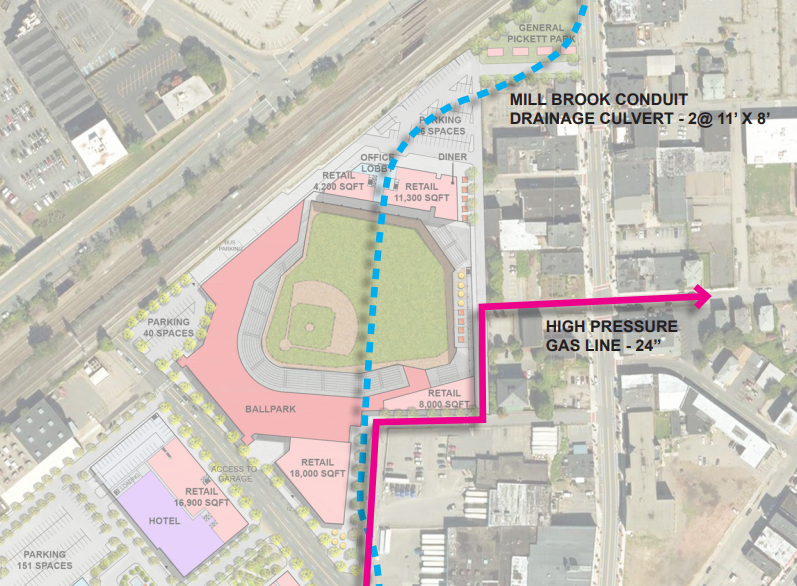
The city hasn’t detailed what ballpark design features were changed for cost savings, and officials maintain Polar Park will be a world-class ballpark. Polar Park’s capacity was reduced slightly to 9,508 from an often-mentioned 10,000-person figure, making Polar Park the smallest in the 14-team International League, and 5% smaller than the team’s McCoy Stadium in Pawtucket, R.I. At the total cost of $159.5 million for land acquisition, site preparation and construction, Polar Park is the most expensive minor league ballpark ever built, beating out the inflation-adjusted $153-million home of the Las Vegas Aviators.
Augustus called the city-built project more expensive than if the team had built a private stadium, because public projects are more expensive due to use of higher-wage union labor. Per the requirements of the construction contracts, 95% of the project used union labor, and the construction workforce is 22% Worcester residents, 22% people of color, and 6% women.
“Public construction projects almost always yield a higher cost than private projects,” Augustus said. “This structure is one reason why Polar Park will be more expensive than other privately constructed minor league ballparks across the country.”
Paying for itself
Despite the latest cost increases, city officials still believe the stadium will pay for itself over 35 years, Dunn said, with taxes from a special district around the ballpark and other revenues directly from WooSox and stadium-related activities covering the $88.2 million in expenses the city is responsible for.
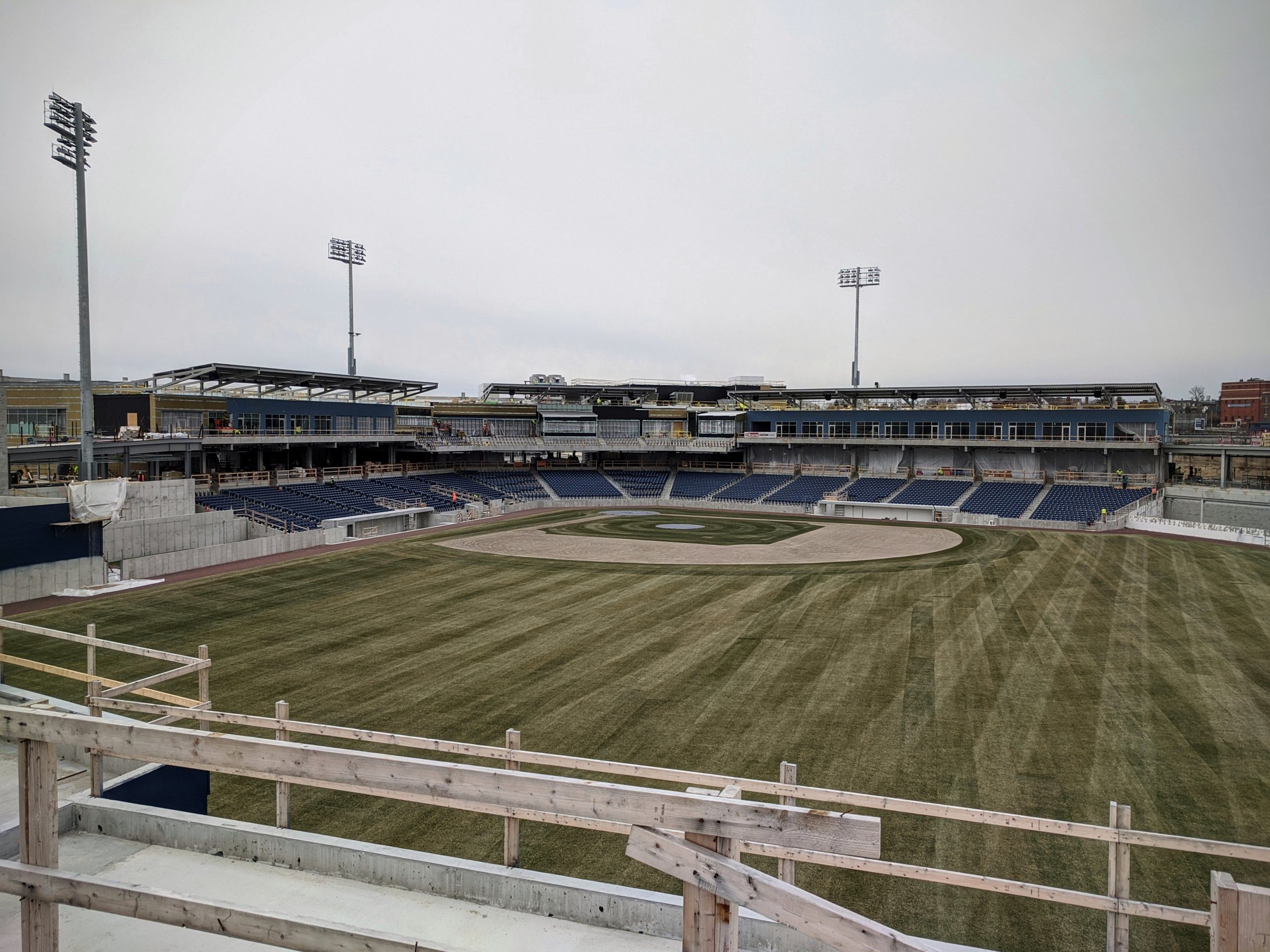
In announcing the cost overruns on Jan. 8, Augustus did not provide the City Council with an updated pro forma of how exactly those expenses would be offset by stadium-related revenues, as he did in January 2020 when the cost estimate increased from its initial $100.8 million to $132 million. In that instance, the city expanded the size of the special taxing district, among other measures, to make up the difference. A new pro forma is being created.
Yet, despite the latest estimate rising to $159.5 million on Jan. 8, the city’s cost responsibilities remained relatively the same as they were in January 2020. With the new expenses, the WooSox are picking up the construction expense increase, and state and federal grants offset other aspects of the project.
Even as the project costs have risen over the past two years, the City Council and the Worcester Redevelopment Authority, which technically owns the ballpark site, have been overwhelmingly supportive of Polar Park, unanimously approving contracts and updated financing deals for the stadium and the related surrounding development.
“Some people stress just the finances,” City Councilor Gary Rosen said in the Jan. 12 City Council meeting, comparing the monetary costs against the feel-good and intangible benefits the team will bring. “They don’t like the finances, so we can’t have baseball.”
Because of the initial decision on where to build the stadium, Dunn said costs would have likely remained consistent with their final total no matter how quickly the stadium came together.
“I don’t know that the costs could have been mitigated,” he said.
